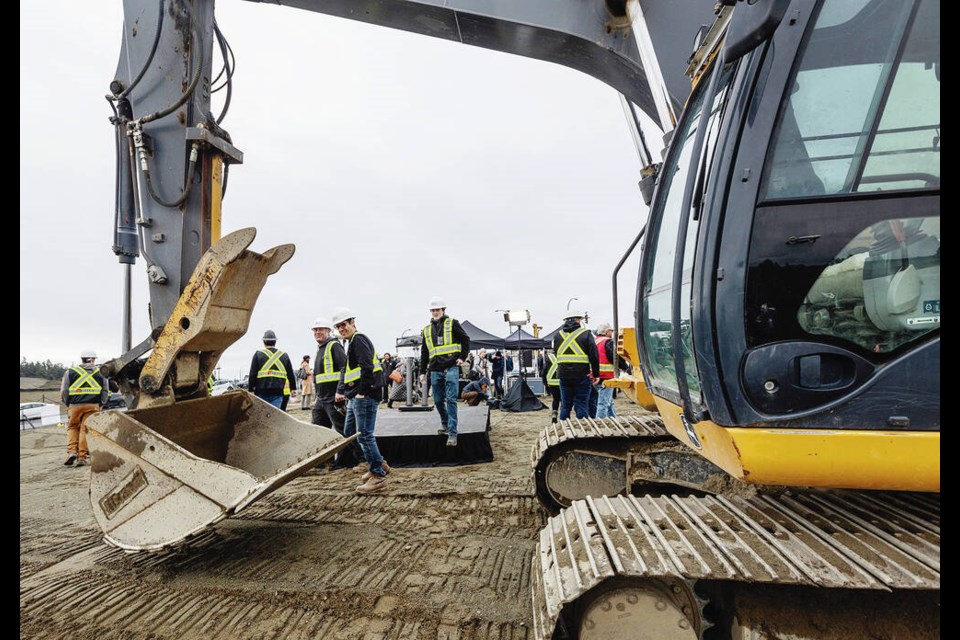Colwood’s growing population will get even more of a boost over the next decade, now that work on a development that’s expected to bring 2,850 new homes to a waterfront area off Metchosin Road is officially underway.
Excavators broke ground Monday on the $1.2-billion Beachlands — formerly Royal Beach — development on a 134-acre stretch of waterfront.
It’s the last chunk of the former gravel quarry to be developed, after the Royal Bay lands on the other side of Metchosin Road.
Beachlands is expected to be home to up to 4,000 new residents and provide 47 acres of green space and parks, a central plaza and several new businesses in what developers are calling a “destination seaside community.”
The build-out along 1.4 kilometres of shoreline is expected to take 15 years and generate thousands of construction jobs as well as jobs in pubs, restaurants, a market, fitness centre and other service-oriented businesses associated with the finished development, according to Seacliff Properties and Reliance Properties.
Mayor Doug Kobayashi said Colwood is already one of the fastest-growing centres in the capital region — trailing only Langford in growth rate over the past decade. The number of residents jumped 12.5% to 19,000 between the 2016 and 2022 census reports, and the mayor said Colwood’s population is now estimated at more than 22,000.
Between the Beachlands and Royal Bay developments and the potential for hundreds more homes in the Allendale District and around the city’s centre, Kobayashi said Colwood’s population could surpass 38,000 even under “a medium growth projection” in the next two decades.
A growth surge is also expected around Colwood’s town centre as property owners explore development opportunities around the new Galloping Goose crossing in the area between Island Highway, Wale Road and Goldstream Avenue as part of a 30- to 50-year “gateway” visioning process.
“We’re seeing about 200 new houses a year right now, growing by about 800 people a year,” said Kobayashi. “By the time we finish with Royal Bay and Beachlands, that’s 7,000 new homes — and we only had 8,500 homes [before they started.]
“But the 50-year vision will see a lot more.”
At Beachlands, initial construction includes a 12,000-square-foot presentation centre expected to open in summer 2025 that will later be transformed into a restaurant or another business.
Seacliff Properties said two multi-family buildings totalling 181 homes will start this year, including townhomes slated for completion in summer 2026.
Beachlands will be a collection of neighbourhoods with single-family houses, townhomes and condominiums ranging from six to 12 storeys, its developers say.
Jon Stovell, president and CEO of Reliance Properties, said the project is moving ahead despite the challenges posed by high interest rates.
“While the Beachlands will fulfil some of the desperate need for homes — including missing-middle housing geared to families — housing in the area and British Columbia remains in short supply to meet the high population demands now and in the future,” he said.
Reliance is also re-imagining 6.7 acres of Victoria’s downtown around the Capital Iron lands on Store Street in what would be one of the biggest developments in the city, which could include a new home for the Art Gallery of Greater Victoria.
Reliance built the Janion project and is redeveloping the historic Northern Junk properties near the Johnson Street Bridge.
The Beachlands and Royal Bay sites were a rock and gravel mine for just over a century, where aggregates were loaded onto barges along the shore. The pit was exhausted in 2008, and Seacliff bought the site in 2017. Reliance came in as a partner in 2022.
The City of Colwood has envisioned development on the pit site since the late 1990s, and adopted a new sub-area plan and zoning bylaw for Beachlands in 2021.
Kobayashi called Monday’s groundbreaking a “very important milestone.” “It is going to be a world‑class destination. It’s well planned and [there’s been] lots of great work by city staff to get it to this point.”
The mayor acknowledged traffic congestion will become an issue once the site is built out.
Land has been set aside at Beachlands for a ferry terminal for a proposed commuter route from Royal Beach to downtown Victoria. But how long that land will be reserved depends on the results of a provincial government feasibility study on whether a commuter ferry will be cost-effective.
Details of that study are still being worked out, said Stovell, adding the companies are only obliged to keep the land free, “in case they run a ferry,” for a couple of years.
Stovell said it would be up to B.C. Ferries to buy or lease the property, but “at this point, it looks like a bit of a long shot.”
“I think B.C. Ferries has other issues to deal with,” said Stovell. “Also, some of the initial feasibility work that was done I believe concluded that several times during the year they wouldn’t be able to run a ferry.”
Juan de Fuca Strait is known for strong winds, particularly in winter months, which could make travel in a smaller vessel difficult.
Kobayashi said a feasibility study done by Black Ball Ferry Line indicated the run from Beachlands to downtown Victoria wasn’t feasible because of weather.
The mayor said he is more in support of increasing transit service and cycling lanes, while supporting potential commuter rail to alleviate traffic congestion.



